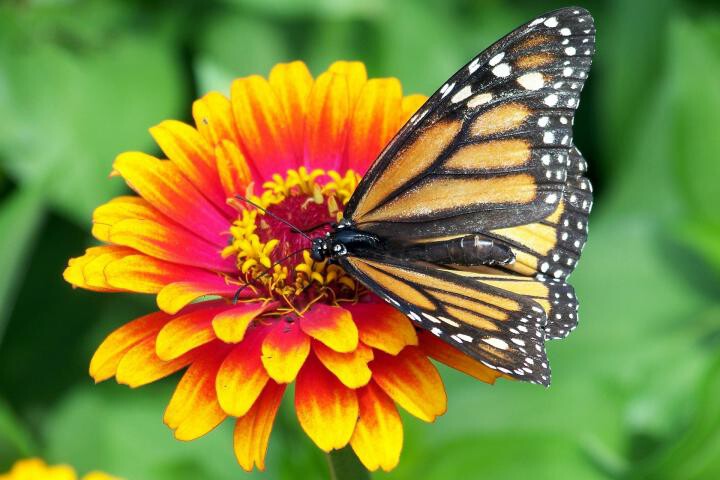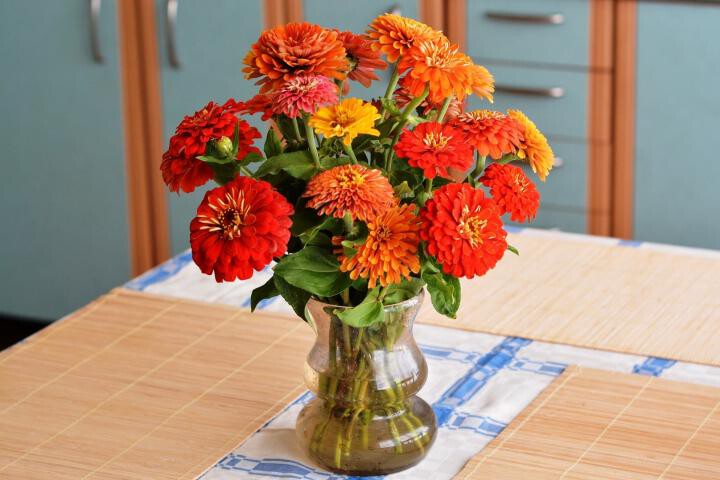Zinnias are one of the easiest flowers to grow, as they grow quickly and bloom heavily. Zinnia flowers can create a massive burst of color in your garden, so consider trying them this year!
Zinnias are annuals, so they’ll grow for one season and produce seeds, but the original plant will not come back in subsequent years. They have bright, solitary, daisy-like flowerheads on a single, erect stem, which makes them great for use as a cutting flower or as food for butterflies.
TYPES OF ZINNIAS
The most popular zinnia species is Zinnia elegans, which has been bred to produce a great number of unique varieties.
There are three main kinds of zinnia flowers: single, semidouble, or double. The distinction between these forms comes from the number of rows of petals and whether or not the center of the flower is visible:
Single-flowered zinnias have a single row of petals and a visible center.
Double-flowered zinnias have numerous rows of petals and their centers are not visible.
Semidouble-flowered zinnias are somewhere in-between, with numerous rows of petals but visible centers.
In addition to these forms, zinnia flowers come in a number of shapes, including “beehive,” “button,” and “cactus.” The plants themselves also come in different heights: taller varieties are best for the background of a garden bed, while shorter varieties work well along a border. There’s really a zinnia for every garden!
Plant zinnias in an annual or mixed border garden. Smaller zinnias are suitable for edging, windowboxes, or other containers.
PLANTING
WHEN TO PLANT ZINNIAS
It’s recommended that you grow zinnia from seed right in the garden bed, as they do not like to be transplanted and do not often thrive. From seed, they will grow very quickly in the right conditions.
Note: Zinnias can be started from seed indoors if you prefer—just transplant them while they’re young and do so carefully.
Zinnias are sensitive to frost, so do not seed until the last frost has passed. See your local frost dates.
Zinnias will grow in a minimum daytime temperature of about 60°F (16°C), though a range of 74–84°F (23–28°C) is preferred.
Sow a round of seeds every week or so for several weeks to extend the flowering period.
CHOOSING AND PREPARING A PLANTING SITE
Choosing a location that gets full sun is essential.
Good air circulation will help to prevent foliar diseases such as powdery mildew later in the season.
Zinnias are adaptable to most soil conditions, but the ideal soil will be rich in organic matter and well-drained.
Soil pH should be between 5.5 and 7.5.
If soil is amended with compost, the flowers will grow more quickly. Learn more about soil amendments and preparing soil for planting.

HOW TO PLANT ZINNIAS
Space plants 4 to 24 inches apart, depending on variety. (Many common varieties are planted 6 inches apart within the row and 2 feet in between rows.) See back of seed packet for variety-specific advice.
Sow zinnia seeds only about ¼-inch deep.
You’ll see zinnia seedlings in only 4 to 7 days for most varieties, though it will be anywhere from several weeks to a couple months before blooms appear (depending on planting site and climate).
When seedlings reach three inches tall, thin them so that they’re 6 to 18 inches apart to maximize air circulation. This reduces the chance of powdery mildew developing.
CARE
HOW TO CARE FOR ZINNIAS
Maintain moderate soil moisture and fertilize lightly to maximize growth and blooms.
After zinnias flower, cut off the old flowers (a process called “deadheading”) to encourage more flowers to form.
Zinnias are annuals and will die with the first hard frost of fall. If you want them to reseed, let the last flowers of the season mature fully and scatter their seeds.
PESTS/DISEASES
Bacterial and fungal spots, powdery mildew, and bacterial wilt may affect zinnias. Minimize wetting of foliage and space plants properly to avoid disease.
Caterpillars, mealybugs, and spider mites also cause problems. Some leaf damage is not an issue, so avoid spraying unless there’s a true infestation.
Luckily, zinnias are deer-resistant, so they might help keep nearby flowers from being eaten.
HARVEST/STORAGE
Zinnias generally take 60 to 70 days from seed to flower (though it depends on conditions and variety). They work great in a flower bouquet!

RECOMMENDED VARIETIES
Get a full-size flower on a compact plant with cultivars of the Dreamland Series. Dwarf and compact, these zinnias have fully double flowerheads, up to 4 inches across in a wide color range; stems are 8–12 inches tall.
The Thumbelina Series cultivars are dwarf and spreading, with single or semi-double, weather-resistant flowerheads in many colors. Their petals are 1-¼ inch across and stems grow up to 6 inches long.
The State Fair Series are one of the biggest and tallest of them all, with large, double flowerheads that are 3 inches across. Stems grow to 30 inches tall.
WIT & WISDOM
The small, narrow-leaf zinnias work well in hanging baskets and make for nice dried flowers, too.
It’s said that zinnias symbolize thoughts of absent friends.